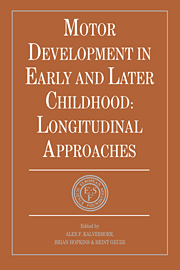Book contents
- Frontmatter
- Contents
- List of contributors
- Foreword
- Preface
- SETTING THE SCENE
- SECTION I BIOLOGICAL BASIS OF MOTOR DEVELOPMENT
- SECTION II DEVELOPMENT OF BODY POSTURE AND GOAL-DIRECTED REACHING
- SECTION III MOTOR DEVELOPMENT, EARLY COMMUNICATION AND COGNITION
- SECTION IV ACQUISITION OF SKILLS
- 12 Individual patterns of tool use by infants
- 13 Tool use, hand cooperation and the development of object manipulation in human and non-human primates
- 14 Handwriting: a developmental perspective
- 15 Development of children's writing performance: some educational implications
- SECTION V MOTOR DEVELOPMENT AND HANDICAP
- SECTION VI METHODOLOGICAL AND CONCEPTUAL CONSIDERATIONS
- Epilogue: description versus explanation
- Index
13 - Tool use, hand cooperation and the development of object manipulation in human and non-human primates
from SECTION IV - ACQUISITION OF SKILLS
Published online by Cambridge University Press: 05 May 2010
- Frontmatter
- Contents
- List of contributors
- Foreword
- Preface
- SETTING THE SCENE
- SECTION I BIOLOGICAL BASIS OF MOTOR DEVELOPMENT
- SECTION II DEVELOPMENT OF BODY POSTURE AND GOAL-DIRECTED REACHING
- SECTION III MOTOR DEVELOPMENT, EARLY COMMUNICATION AND COGNITION
- SECTION IV ACQUISITION OF SKILLS
- 12 Individual patterns of tool use by infants
- 13 Tool use, hand cooperation and the development of object manipulation in human and non-human primates
- 14 Handwriting: a developmental perspective
- 15 Development of children's writing performance: some educational implications
- SECTION V MOTOR DEVELOPMENT AND HANDICAP
- SECTION VI METHODOLOGICAL AND CONCEPTUAL CONSIDERATIONS
- Epilogue: description versus explanation
- Index
Summary
INTRODUCTION
One of the distinguishing characteristics of human intelligence is the use of external objects to facilitate goal-directed activities. Without the use of external objects as tools, most of the artifices that make up human culture would not be possible. Due to its crucial role in human evolution, tool use was thought for a long time to be an exclusive ability of humans. However, since the experiments of Koehler (1925) and the observations of Goodall (1968) on chimpanzees, we know that this species (among other non-human primates) is able to use objects to attain different goals, as exemplified in the use of sticks to ‘fish’ for termites and ants.
In reality, the evidence for tool use, defined in its broadest sense, is not limited to primates. Thus, a variety of birds, lower mammals and even some fish incorporate external objects into their activities (Beck, 1980). For example, seagulls drop clams onto rocks in order to break them. If we want to confer special status to primate tool use, it will be necessary to distinguish it from other cases of tool use in the animal kingdom. For that purpose, a taxonomy for distinguishing various forms of object manipulation and tool use has been proposed by Parker & Gibson (1977). Their classification rests on the definition of complex object manipulation considered as ‘the manipulation of one detached object relative to another involving subsequent change of state of one or both of the objects’ (Parker & Gibson, 1977, p. 624).
- Type
- Chapter
- Information
- Motor Development in Early and Later ChildhoodLongitudinal Approaches, pp. 205 - 216Publisher: Cambridge University PressPrint publication year: 1993
- 3
- Cited by



